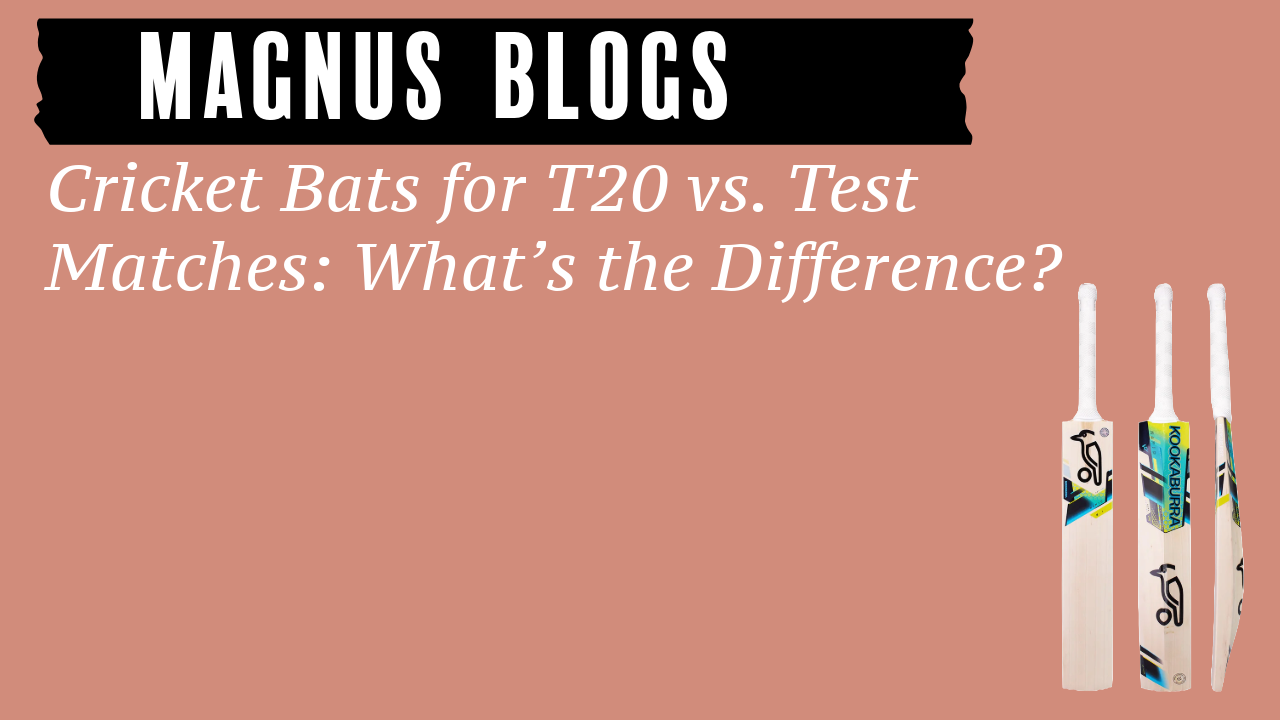Cricket is a sport that demands precision, skill, and the right equipment for different formats. One of the most crucial elements of a player's gear is the cricket bat, and its design varies significantly based on whether it is used in Test cricket or T20 matches. While both formats require high-quality bats, the structural differences cater to different playing styles, pitch conditions, and match durations. Let’s explore the key differences between bats used in T20 and Test matches.
1. Bat Profile and Thickness: Power vs. Control
T20 Cricket Bats:
-
Thicker Blades & Bigger Edges: Modern T20 bats have thick profiles and large edges to maximize power.
-
High Spine for Power Hitting: A high spine creates a larger sweet spot, making it easier to clear the boundary.
-
Shorter Blade, Longer Handle: Some T20 bats have shorter blades to allow more bat speed and maneuverability for quick strokes.
Test Cricket Bats:
-
Traditional Blade Profile: Test bats prioritize balance and control, with a more even weight distribution.
-
Thinner Edges: Unlike T20 bats, Test bats have relatively thinner edges, focusing on timing over brute force.
-
Lower Sweet Spot: Designed for playing along the ground, favoring technique over aggressive hitting.
2. Willow Quality: Durability vs. Explosiveness
T20 Cricket Bats:
-
High-Performance, Lightweight English Willow: T20 bats are made from premium English willow with minimal pressing to maximize rebound effect.
-
Designed for Power Shots: The willow is softer and optimized for maximum stroke-making ability.
-
Shorter Lifespan: Due to heavy hitting, T20 bats wear out faster than Test bats.
Test Cricket Bats:
-
Denser, More Pressed Willow: Test bats undergo additional pressing to improve durability and control.
-
Designed for Longevity: These bats last longer, as Test matches demand sustained play over multiple days.
-
Better Shock Absorption: The willow’s compression helps withstand prolonged batting sessions.
3. Weight and Pickup: Speed vs. Stability
T20 Cricket Bats:
-
Slightly Heavier for Power Hitting: The added weight helps generate momentum for sixes.
-
Light Pickup for Quick Shots: Despite the weight, the design ensures easy maneuverability for innovative stroke play.
-
Short Handle for Wristy Shots: Helps in playing ramp shots, scoops, and switch-hits effectively.
Test Cricket Bats:
-
Balanced Weight Distribution: A well-balanced bat helps players with long innings and controlled strokes.
-
Lighter Overall Weight: Allows for better technique, focusing on defensive play and precise shot selection.
-
Longer Handle for Classic Strokes: Supports proper footwork and controlled stroke-making.
4. Playing Style and Format Influence
T20 Cricket Bats:
-
Optimized for Aggressive Batting: Built for explosive shots, maximizing runs in a short span.
-
Favors Limited Overs Play: Since T20 innings are short, the bat is tailored for big shots rather than long innings.
-
Supports Innovation: Ideal for reverse sweeps, switch-hits, and helicopter shots.
Test Cricket Bats:
-
Designed for Technique & Defense: Helps batsmen build long innings with patience.
-
Adapts to Various Conditions: Ideal for different pitch conditions, including slow turners and seaming tracks.
-
Favors Classical Batting Strokes: Suited for cover drives, straight drives, and elegant cuts.
5. Durability and Lifespan
T20 Cricket Bats:
-
Shorter Lifespan: Frequent powerful hitting leads to quicker wear and tear.
-
Requires Frequent Replacements: Professional T20 players often switch bats after a few games.
Test Cricket Bats:
-
Longer Lifespan: Built to last through extensive batting sessions.
-
Minimal Stress on the Willow: Controlled shots reduce impact damage, preserving the bat’s structure.
Conclusion: Choosing the Right Bat for the Right Format
Both T20 and Test cricket bats serve distinct purposes, catering to the demands of their respective formats. T20 bats are engineered for aggressive, power-driven play, while Test bats emphasize technique, balance, and longevity. Choosing the right bat depends on a player’s playing style, match format, and personal preference. Whether you're aiming for explosive sixes in a T20 game or crafting a patient century in a Test match, selecting the right bat can make all the difference in your performance.
#MagnusCricket #CricketGear #CricketBats #T20Cricket #TestCricket #PowerHitting #CricketInnovation #CricketEquipment
